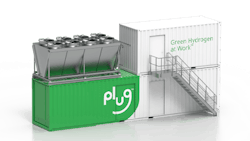Data Center Hydrogen Power Is Making Strides, But Can It Ramp Fast Enough?
There is little question that hydrogen fuel cells hold a lot of promise for data center power and general power generation for industrial use.
But as we have mentioned before, the availability of hydrogen is dependent on a number of factors, not the least of which is hydrogen generation and distribution.
Plug Power, which started making waves in 2022 when it built a 3 MW hydrogen powered generation system for Microsoft, believes that we are on the cusp of seeing a more general use of hydrogen fuel cells for adding power to the grid.
Although, as Plug Power CEO Andrew Marsh said, “I don’t think it’s a 2024 event. I think it could be a late 2025 event where you start seeing some deployments at scale.”
But Marsh isn’t referring to the concept of having hydrogen power on-site for backup power.
He expects customers to be able to do peak load shaving, making use of the power generation capability as a regular part of a site’s power generation plan.
And with the ongoing efforts to make data centers better citizens of the power grid, this on-site power generation capability to not only backstop, but also supplement the grid, should find a lot of support in the industry.
Shades of Green
While hydrogen power is considered a green energy solution, it is important to realize that the most efficient method of generating hydrogen for use as fuel, electrolysis - a process that separates the hydrogen and oxygen molecules of water - requires electricity.
And to take advantage of the fact that this production is itself a green process, the source of that electricity needs to be considered.
So if a company is getting their power from fossil fuel power generation plants, the hydrogen isn’t as green as it could be.
Vertical Integration is Key
This is one of the reasons why Plug Power is building an end-to-end hydrogen power solution. In January of this year they announced that they had started the operation of a green liquid hydrogen plant in Woodbine, Georgia.
Plug tells us that this move showcases their commitment to a vertically integrated hydrogen ecosystem.
While not explicitly stated, one can presume that the power source for the plant is nuclear, as the newest nuclear power generation facility in the US opened last year in Georgia.
The Woodbine plant is designed to produce 15 tons per day of liquid electrolytic hydrogen using eight 5-megawatt (MW) PEM electrolyzers.
PEM Logistics
In a PEM [polymer electric membrane] electrolyzer, water is passed to an anode where it reacts to form hydrogen ions and oxygen. The hydrogen gas is then condensed into liquid form at -423F.
Plug has its own logistics network which uses cryogenic trailers to deliver liquid hydrogen to customers’ hydrogen fueling stations.
The newest plant was spun up in approximately 18 months - roughly half the start-up time usually associated with the creation of hydrogen fuel plants - and comes on the heels of Plug's successful pilot program in Georgia.
The pilot has been operating a single 5 MW electrolyzer for more than 12 months.
Hydrogen Market View
Plug isn’t the only producer of hydrogen fuel cells for power generation at scale.
Bloom Energy is probably the best-known player in this space, with their solid oxide fuel cells being introduced in 2001, and now offering fully integrated microgrid configurations to their customers.
While liquid hydrogen and solid oxide technologies differ in manufacture and operation, they both deliver green energy to the user.
Both technologies are securing the future for hydrogen power generation for commercial and industrial applications, and a practical one at that.
Hydrogen as a widespread energy source for data centers has of course been on the industry's radar for years. If companies like Plug Power and Bloom have their way, data centers' fullblown hydrogen-powered future could be much closer than previously anticipated.






